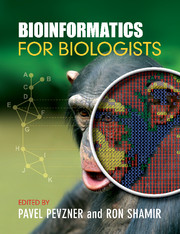Book contents
- Frontmatter
- Contents
- Extended contents
- Preface
- Acknowledgments
- Editors and contributors
- A computational micro primer
- PART I Genomes
- PART II Gene Transcription and Regulation
- PART III Evolution
- PART IV Phylogeny
- 12 Figs, wasps, gophers, and lice: a computational exploration of coevolution
- 13 Big cat phylogenies, consensus trees, and computational thinking
- 14 Phylogenetic estimation: optimization problems, heuristics, and performance analysis
- PART V Regulatory Networks
- REFERENCES
- Glossary
- Index
12 - Figs, wasps, gophers, and lice: a computational exploration of coevolution
from PART IV - Phylogeny
Published online by Cambridge University Press: 05 June 2012
- Frontmatter
- Contents
- Extended contents
- Preface
- Acknowledgments
- Editors and contributors
- A computational micro primer
- PART I Genomes
- PART II Gene Transcription and Regulation
- PART III Evolution
- PART IV Phylogeny
- 12 Figs, wasps, gophers, and lice: a computational exploration of coevolution
- 13 Big cat phylogenies, consensus trees, and computational thinking
- 14 Phylogenetic estimation: optimization problems, heuristics, and performance analysis
- PART V Regulatory Networks
- REFERENCES
- Glossary
- Index
Summary
This chapter explores the topic of coevolution: the genetic change in one species in response to the change in another. For example, in some cases, a parasite species might evolve to specialize with its host species. In other cases, the relationship between two species may be mutually beneficial and coevolution may serve to strengthen the benefits of that relationship.
One important way to study the coevolution of species is through a computational technique called cophylogeny reconstruction. In this technique, we first obtain the evolutionary (phylogenetic) trees for the two species and then try to map one tree onto the other in the “simplest” (most parsimonious) possible way. We can then use these mappings to determine how likely it is that the two species coevolved.
This chapter begins with descriptions of several pairs of species that are believed to have coevolved: figs and the wasps that polinate them; gophers and the lice that infest them; and a bird species that “tricks” another species to tend to its young. Next, we describe the cophylogeny reconstruction problem, its computational complexity, and a technique for finding good solutions for this problem. Finally, the reader is invited to use this computational method – through a freely accessible software package called Jane – to investigate the relationships between the pairs of species described at the beginning of the chapter.
Introduction
I can understand how a flower and a bee might slowly become, either simultaneously or one after the other, modified and adapted in the most perfect manner to each other, by the continued preservation of individuals presenting mutual and slightly favourable deviations of structure.
- Type
- Chapter
- Information
- Bioinformatics for Biologists , pp. 227 - 247Publisher: Cambridge University PressPrint publication year: 2011
- 3
- Cited by

